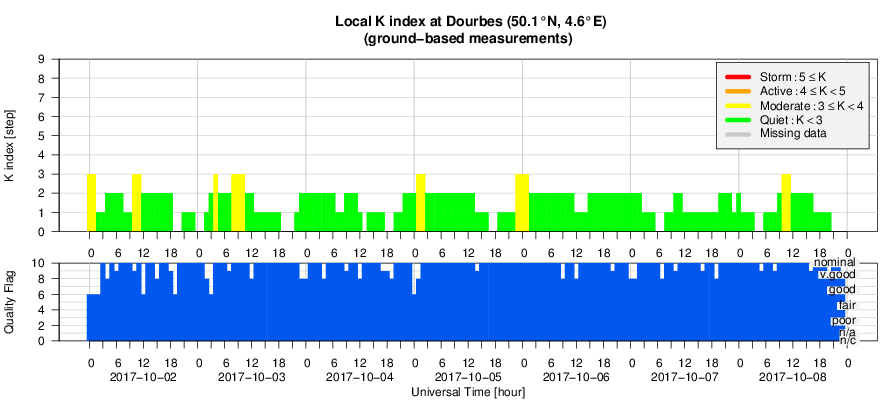- Table of Content
- 1.The Sun is spo...
- 2.The esww14 the...
- 3.PROBA2 Observa...
- 4.Review of sola...
- 5.The Internatio...
- 6.Geomagnetic Ob...
- 7.The SIDC space...
- 8.Review of iono...
- 9.Future Events
2. The esww14 theme picture has arrived
3. PROBA2 Observations (2 Oct 2017 - 8 Oct 2017)
4. Review of solar and geomagnetic activity
5. The International Sunspot Number
6. Geomagnetic Observations at Dourbes (2 Oct 2017 - 8 Oct 2017)
7. The SIDC space weather Briefing
8. Review of ionospheric activity (2 Oct 2017 - 8 Oct 2017)
9. Future Events
The Sun is spotless again!
Last week, only one C-class flare was observed (on 5 October), with flaring activity mostly restricted to low-level B-class events. The two main sunspot groups, NOAA 2682 and NOAA 2683, both had relatively simple magnetic configurations and so were not able to produce more intense flaring. Nonetheless, some of the eruptive events were very nice in EUV imagery (Extreme Ultraviolet), such as the one starting on 6 October around 08:00UT. The image underneath shows a nice cusp (flamelike structure, indicative of magnetic reconnection) in SDO/AIA 094 (hot parts of the solar corona) on the right, with post-eruption coronal loops at lower temperatures of about 700.000 degrees to the left (SDO/AIA 171; https://sdo.gsfc.nasa.gov/ ).
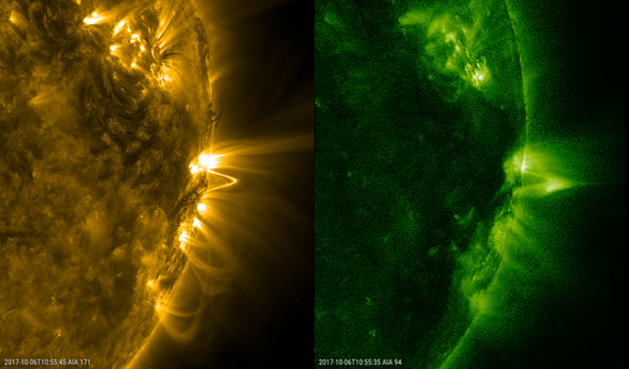
NOAA 2682 and NOAA 2683 were the remnants of respectively NOAA 2673 and 2674, those two big sunspot regions responsible for intense solar activity just one month ago (a solar rotation). NOAA 2673 was the source of the two most powerful flares so far this solar cycle (see the news items at http://www.stce.be/news/402/welcome.html and http://www.stce.be/news/400/welcome.html ). SDO/HMI imagery underneath shows the difference in outlook of the solar disk between last week (right) and last month (left).
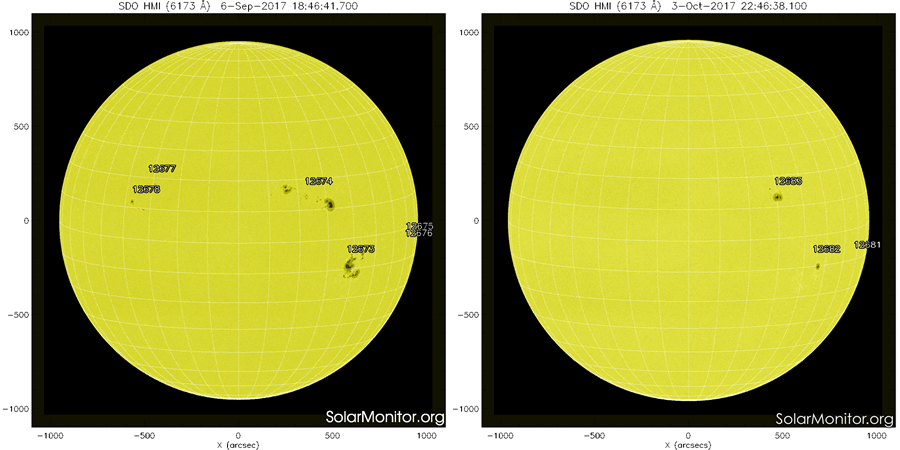
As could be expected with NOAA 2682 and NOAA 2683 rounding the west limb, the Sun has turned spotless since 8 October. These were the first spotless days in more than 2 months. Temporary increases ("hick-ups") in sunspot and solar activity are fairly common during the declining phase of the solar cycle. The evolution of the daily sunspot number and of the number of spotless days can be followed on the SILSO webpage at resp. http://sidc.oma.be/silso/eisnplot and http://sidc.oma.be/silso/spotless There's still a long way to go to the next solar cycle minimum.
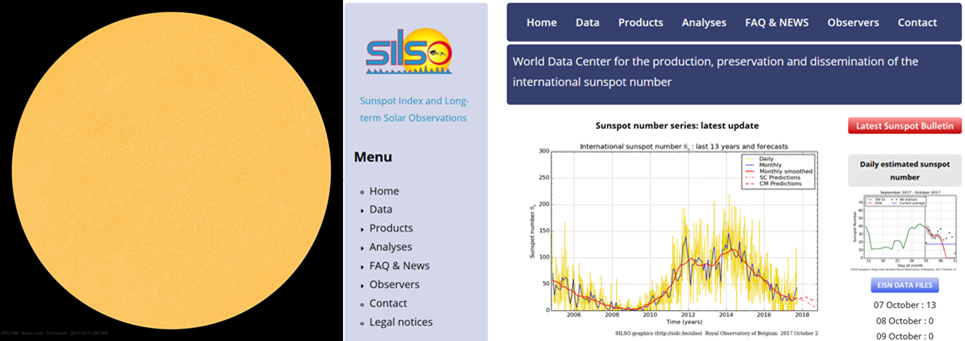
The esww14 theme picture has arrived
The five member jury of the 'Design 4 a Ticket' contest announced the winner: Christina Plainaki. She won a full week esww14 ticket.
Congratulations!
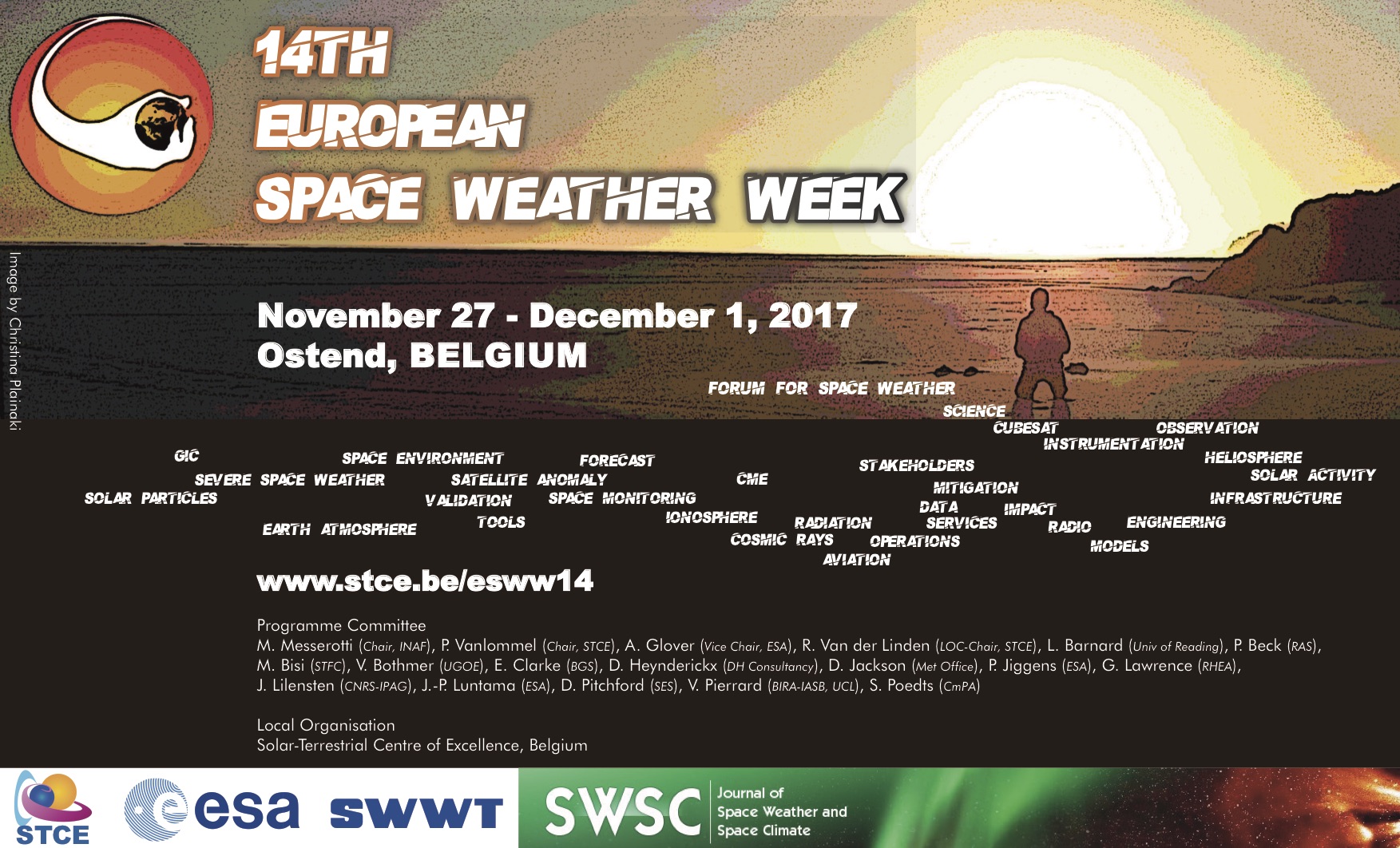
PROBA2 Observations (2 Oct 2017 - 8 Oct 2017)
Solar Activity
Solar flare activity fluctuated between very low and low during the week.
In order to view the activity of this week in more detail, we suggest to go to the following website from which all the daily (normal and difference) movies can be accessed: http://proba2.oma.be/ssa
This page also lists the recorded flaring events.
A weekly overview movie can be found here (SWAP week 393):
http://proba2.oma.be/swap/data/mpg/movies/weekly_movies/weekly_movie_2017_10_02.mp4
Details about some of this week's events, can be found further below.
If any of the linked movies are unavailable they can be found in the P2SC movie repository here:
http://proba2.oma.be/swap/data/mpg/movies/
Thursday Oct 05
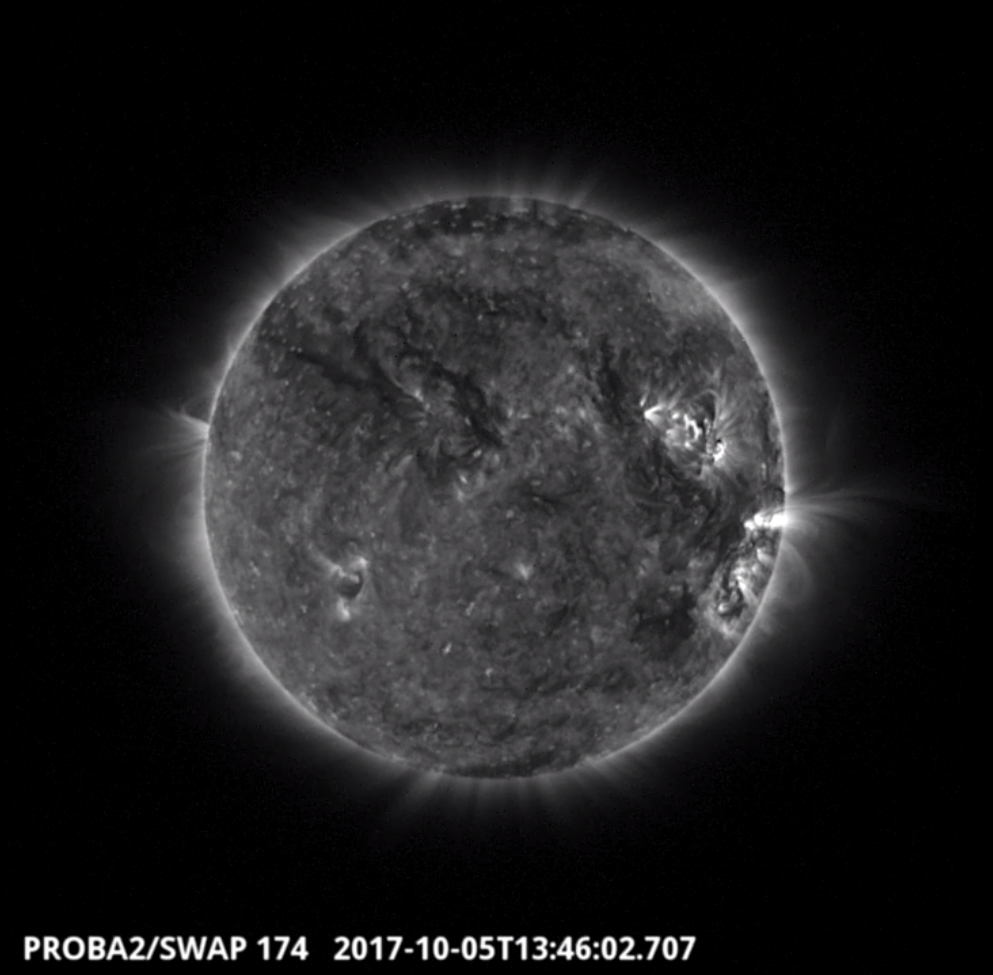
The largest flare of the week was a C-class (C1.0) flare and was observed by SWAP on 2017-Oct-05. The flare is visible in the north-western quadrant of the Sun in the SWAP image above at 13:46 UT.
Find a movie of the event here (SWAP movie):
http://proba2.oma.be/swap/movies/20171005_swap_movie.mp4
Saturday Oct 07
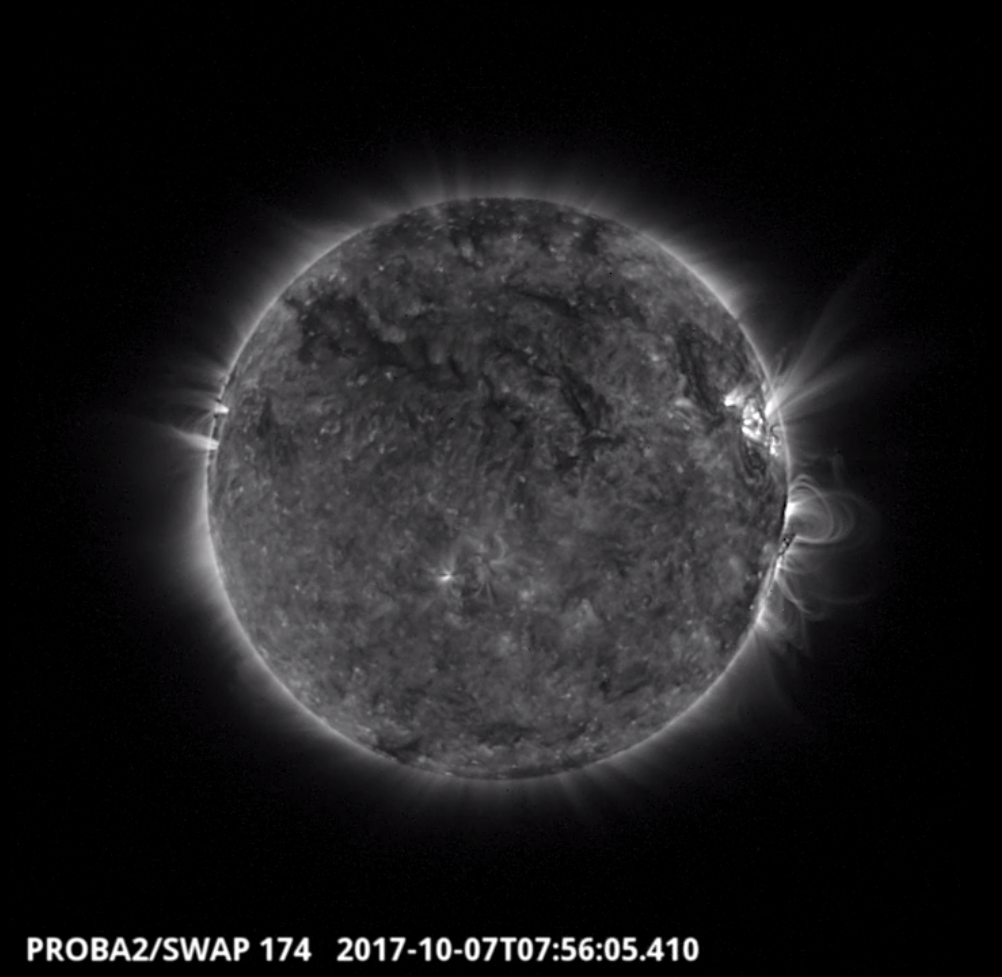
An eruption was observed by SWAP on 2017-Oct-07 and is visible on the western limb of the Sun in the SWAP image above at 07:56 UT.
You can see this event more clearly in the movies of the day found here (SWAP movie):
http://proba2.oma.be/swap/movies/20171007_swap_movie.mp4
and here (Difference movie):
http://proba2.oma.be/swap/movies/20171007_swap_diff.mp4
Review of solar and geomagnetic activity
SOLAR ACTIVITY
Solar activity was very low to low. NOAA 2683 (Catania 57) produced the only C-class flare of the week, a C1 flare on 5 October at 13:41UT. It was also responsible for a long duration event (B4 flare) peaking early on 7 October at 00:28UT. NOAA 2682 (Catania 56) was mostly quiet. A string of filament structures near NOAA 2682 became activated when the region was rounding the Sun's west limb, producing a number of slow-moving, average-sized coronal mass ejections (CMEs) on 6 and 7 October. No earth-directed CMEs were observed throughout the week. By the end of the period, the Sun was spotless. The greater than 10 MeV proton flux was at nominal levels.
GEOMAGNETIC ACTIVITY
At the beginning of the week, the earth environment was under the waning influence of a high speed stream from a positive polarity coronal hole (CH). Solar wind speed declined from about 500 to 400 km/s on 2 October (DSCOVR). A sector boundary crossing was observed on 03 October, with the interplanetary magnetic field changing its direction from away to towards the Sun. Solar wind speed gradually increased starting on 5 October from about 370 km/s to peaks near 470 km/s by noon on 06 October. Solar wind was enhanced, with some parameters suggesting a weak influence from the flow associated with a small negative equatorial CH that transited the central meridian on 1-2 October. Bz was oscillating most of the week between -5 and +5 nT, with some excursions to -8 and +7 nT on 5 October.
Quiet to unsettled geomagnetic conditions were observed throughout the week, with a single active interval in Kp early on 2 October.
The International Sunspot Number
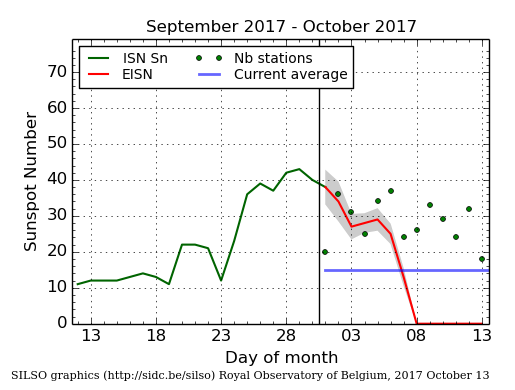
The daily Estimated International Sunspot Number (EISN, red curve with shaded error) derived by a simplified method from real-time data from the worldwide SILSO network. It extends the official Sunspot Number from the full processing of the preceding month (green line). The plot shows the last 30 days (about one solar rotation). The horizontal blue line shows the current monthly average, while the green dots give the number of stations included in the calculation of the EISN for each day.
The SIDC space weather Briefing
The Space Weather Briefing presented by the forecaster on duty from October 2 to 8. It reflects in images and graphs what is written in the Solar and Geomagnetic Activity report.
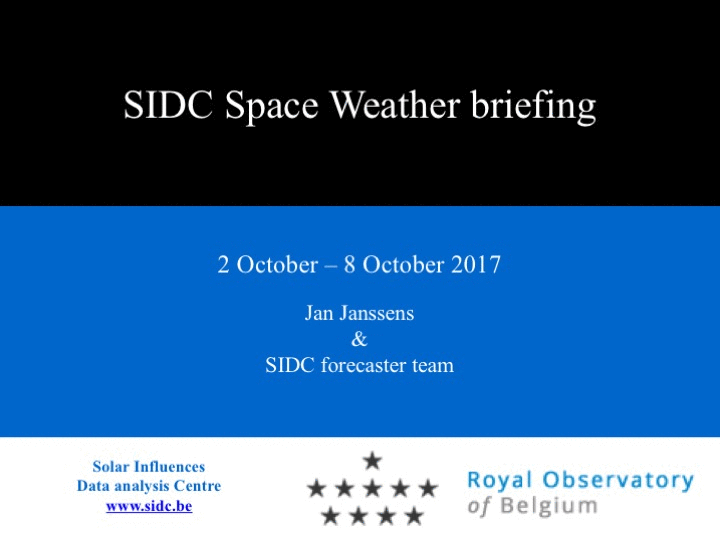
movie SDO/AIA 131, SDO/HMI Cont. and Magn., GONG/H alpha: http://www.stce.be/movies/SWbriefing-1009-JHV_2017-10-06_09.02.16.mp4
movie SDO/AIA 094 and SOHO/LASCO C2: http://www.stce.be/movies/SWbriefing-1009-JHV_2017-10-07_05.55.56.mp4
movie SOHO/LASCO C2 first: http://www.stce.be/movies/SWbriefing-1009-current_c2_combo_05Oct2017.mp4
movie SOHO/LASCO C2 second: http://www.stce.be/movies/SWbriefing-1009-current_c2_combo_08Oct2017.mp4
Review of ionospheric activity (2 Oct 2017 - 8 Oct 2017)
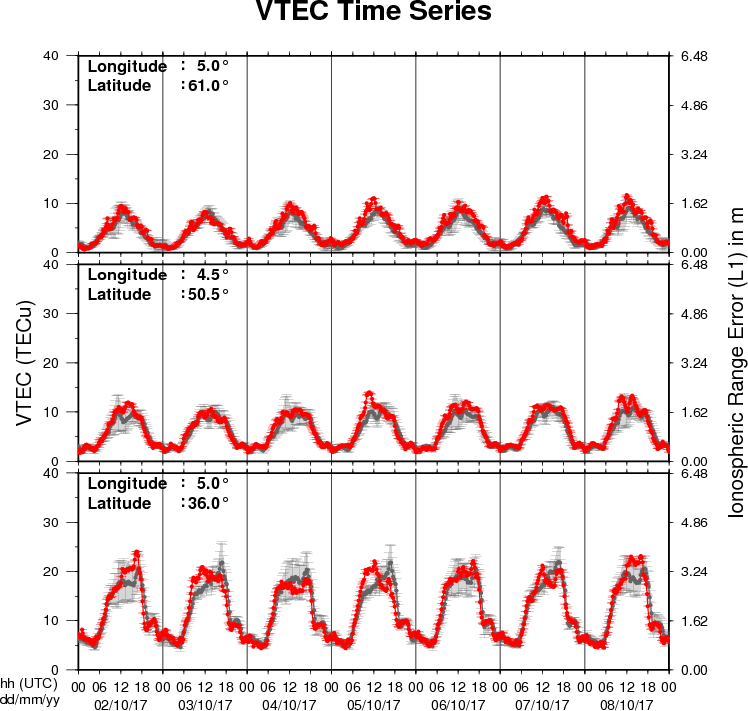
The figure shows the time evolution of the Vertical Total Electron Content (VTEC) (in red) during the last week at three locations:
a) in the northern part of Europe(N61°, 5°E)
b) above Brussels(N50.5°, 4.5°E)
c) in the southern part of Europe(N36°, 5°E)
This figure also shows (in grey) the normal ionospheric behaviour expected based on the median VTEC from the 15 previous days.
The VTEC is expressed in TECu (with TECu=10^16 electrons per square meter) and is directly related to the signal propagation delay due to the ionosphere (in figure: delay on GPS L1 frequency).
The Sun's radiation ionizes the Earth's upper atmosphere, the ionosphere, located from about 60km to 1000km above the Earth's surface.The ionization process in the ionosphere produces ions and free electrons. These electrons perturb the propagation of the GNSS (Global Navigation Satellite System) signals by inducing a so-called ionospheric delay.
See http://stce.be/newsletter/GNSS_final.pdf for some more explanations ; for detailed information, see http://gnss.be/ionosphere_tutorial.php
Future Events
For more details, see http://www.spaceweather.eu/en/event/future
International Workshop on Solar, Heliospheric & Magnetospheric Radioastronomy in Meudon, France
Start : 2017-11-06 - End : 2017-11-10
Jean-Louis Steinbeg has been one of the major pioneers in
radioastronomy. Co-founder of the Nançay Observatory, he
has actively participated to, an inspired a large number of radio
instruments on many international space missions. Jean-Louis
Steinberg is the founder of the Space Radioastronomy laboratory of
the Paris Observatory in 1963. Later on, this laboratory widened
its science interests and became the DESPA (1971) and then the
current LESIA (2002) which is one of the major space sciences
laboratories in France. The aim of this workshop is to cover the
science topics which Jean-Louis Steinberg has promoted during his
career, focusing on Solar, Heliospheric & Magnetospheric
radioastronomy & physics. This will be done by covering both
observations from either ground facilities (NDA, RH, LOFAR, Artemis
etc ...) or space missions (ISSEE, Ulysses, WIND, CLUSTER, STEREO,
CASSINI, JUNO etc ...) and models/theories. A series of invited
talks is also foreseen to cover the new developments in the
discipline which may come with the future facilities such as Solar
Orbiter, Solar Probe Plus, JUICE, JUNO, LOFAR+, SKA etc ....
This workshop will also be the opportunity to remember both the
extraordinary personal & professional lifes of Jean-Louis
Steinberg especially for new generation of scientists. At the
occasion of this workshop it is also expected that the Building 16
(historical Space Sciences building) on the Meudon campus will be
renamed "Building Jean-Louis Steinberg".
Website:
https://jlsworkshop.sciencesconf.org/
European Space Weather Week 14
Start : 2017-11-27 - End : 2017-12-01
The ESWW is the main annual event in the European Space Weather
calendar. It is the European forum for Space Weather as proven by
the high attendance to the past editions. The agenda will be
composed of plenary/parallel sessions, working meetings and
dedicated events for service end-users. The ESWW will again adopt
the central aim of bringing together the diverse groups in Europe
working on different aspects of Space Weather.
Website:
http://www.stce.be/esww14/
